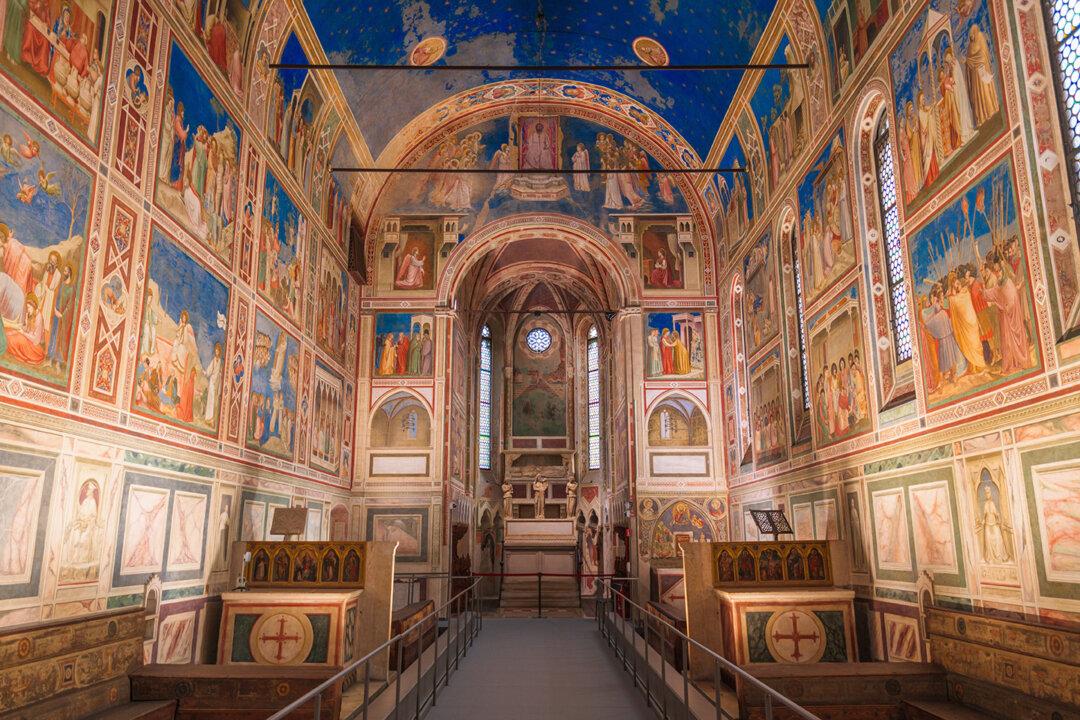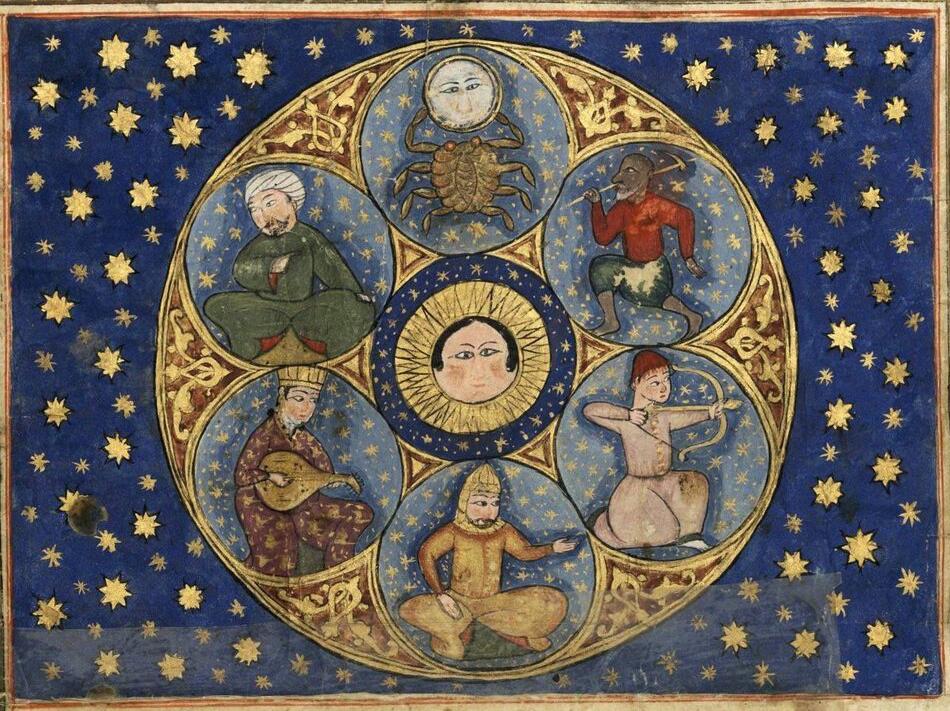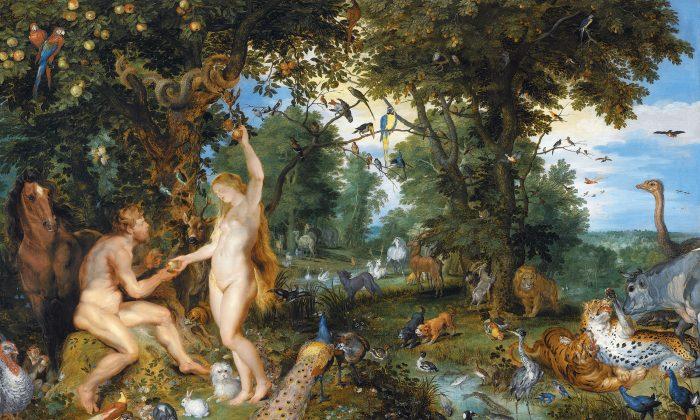One of the greatest treasures of Italian art is the Scrovegni Chapel in Padua, Italy. Given the immensity of much Italian art, this is almost surprising since the Scrovegni Chapel itself is rather a small and enclosed space. Up the road a short distance away is the sublime Basilica of St. Anthony, which is huge in scale and ambition and, in addition to its amazing architecture, includes art by the likes of Donatello. If stupendous size were the only issue, then the Scrovegni Chapel might make a poor showing. But, it doesn’t.
Giotto and His Influence
Giotto, whose paintings adorn the chapel, is a major Renaissance artist. Indeed, some say that he initiated the Renaissance in art because his style affected all subsequent artists. One aspect of his influence was his originality in depicting human emotions. (His friend and contemporary, Dante, did something similar for poetry.)Christian art before Giotto’s time was dominated by icon paintings. These are great pieces of art but they emphasize the divine nature of Christ, which tends to be stylized and static, rather than his humanity. Giotto introduced humanity into Christian art.

For example, if we take a look at “Meeting at the Golden Gate,” which is in the chapel, we see Ann (the mother of the Virgin Mary), who after a long absence rushes to kiss her returning husband, Joachim. A close-up of their faces reveals that he is drawing her toward himself and she is kissing him (lips on lips) very tenderly. There is human love here that goes beyond set pieces that represent theological moments such as Christ on the Cross or Madonna with Child.
This introduction of the human into the art also seems, in Giotto, to have profound theological implications. This is not art for art’s sake, but art for God’s sake, if one may put it that way. There are so many fascinating theological ideas expressed in the art of this small chapel.

To give just one: Facing each other, at the two respective ends of the chapel (west and east) are God the Father, encircled by angels, and Christ at the center of the Last Judgment. The art itself is breathtaking, but what is even more interesting is the deep theology conveyed in the images. The Father and the Son are facing each other across the chapel nave, and they are mirror images! Here is not God the Father—an old man with gray hair, a sort of early Father Christmas type, as is depicted so frequently and mocked frequently in atheistic literature as “the old man in the sky.”


Instead, like Christ, God is young and in his prime, so to speak, eternally. This, of course, aligns with various scriptural references that debunk the old man in the sky idea: most potently when Christ says in John’s Gospel, “Whoever has seen me has seen the Father.” (John 14.9) In other words, one is reflected in the other.
However, leaving aside the big theological issues about the nature of God, what fascinated me most when I visited the chapel recently were the human matters, like the intimacy of Joachim and Ann, or the expression on Judas’s face as he kisses Christ in the garden of Gethsemane, or the 14 portraits by Giotto of the seven deadly sins on the north side of the aisle, facing seven heavenly virtues on the south side—and each one matches.
These 14 portraits are incredible, and so is their purpose: therapy.

Seven Virtues and Seven Vices
Giotto’s seven virtues and deadly vices do not accord exactly with the lists given by Gregory the Great or those by St. Thomas Aquinas (whose list was the basis for Dante’s poem “The Divine Comedy”). According to the expert Giuliano Pisani in his book “The Scrovegni Chapel,” Giotto was influenced by the now largely forgotten theologian Friar Albert of Padua, who himself was particularly influenced by Augustinian theology.This gallery, therefore, had not just aesthetic but also moral and spiritual qualities.
We have, then, seven vices—four cardinal followed by three spiritual—facing their counterpart virtues. What are they?
Fulfilling the four cardinal virtues leads us to the Earthly Paradise, and fulfilling the three spiritual virtues leads to the Heavenly Paradise.
Folly and Prudence
To see how this works, let’s look at the first pairing of Folly and Prudence. The word for “folly” in Latin is “stultitia.” It means more than simply being foolish. Persistent actions that are thoughtless, irrational, and unsound are indicated; it includes ill-advised decision-making and a general state of lacking wisdom or even common sense.Now look at the picture. What do we see?

We see a man with a number of characteristics indicative of lacking sense or wisdom. He’s corpulent, so addicted to sensory pleasures; he’s standing at a slightly cocked angle, so not upright; wearing an exaggerated crown of feathers as if, what? crowning himself; with a matching train of peacock feathers behind as if he thinks himself important or royalty. From his belt little rattles hang, as if compulsively drawing attention to himself as they tinkle; his mouth is open, indicating ignorance—a sort of thoughtless gawping; feet are unshod, which is how animals are; and in his right hand is a big and imperfectly shaped club, suggesting resort to brute force without any finesse (as, for example, a rapier or sword would). In short, we have all that humankind should not be.
Looking at this figure, is that you? Do we see anything of ourselves in this picture? For if we do, we are in deep spiritual trouble!
As we turn south, we see the antidote, the cure! For here, opposite, we see Prudentia who counters Stultitia. “Prudentia” is a Latin word that translates to “prudence” or “wisdom” in English. It refers to the quality or virtue of being cautious, wise, and showing good judgment in decision-making; it’s about the ability to make sound choices based on careful consideration of consequences and a thoughtful evaluation of available options.
Here we see a woman behind the protection of a desk; she is studying, learning, obviously forming a kind of protection against ignorance and thoughtlessness. The desk is part of a study that is elegant and composed, suggesting order and purpose. In her right hand, she holds a compass, signifying science, and in her left hand, a mirror into which she looks: She is obeying the central classical precept of “know thyself.” To do that, we have to engage in a certain form of introspection and see ourselves as we truly are, which is to say, as God sees us. Notice, too, that unlike the man in Stultitia, her head is tilted slightly forward—a typical angle for someone who listens rather than speaks too much. Here, then, is the remedy.
We could go on, but the key point, as Giuliano Pisani points out, is that “the therapy enacted by Prudentia is the remedy enacted against the inability to distinguish what is good, and it enables us to proceed on our pathway.” Put another way, if we don’t know what is good from what is bad in the first place, how can we make any progress in the spiritual life we are all called to?
Time, then, to look at all 14 pictures to see how we are progressing! Do take a look yourself at these remedies for vice.











